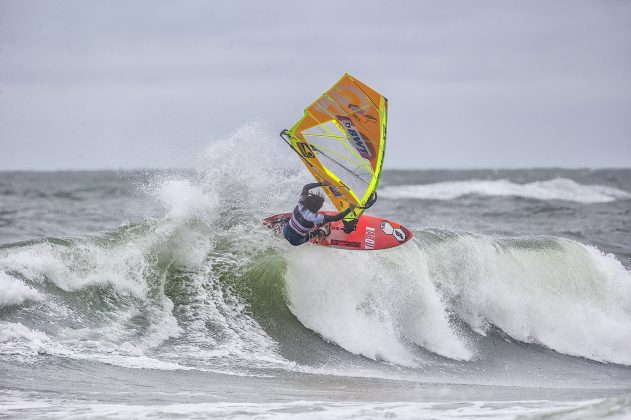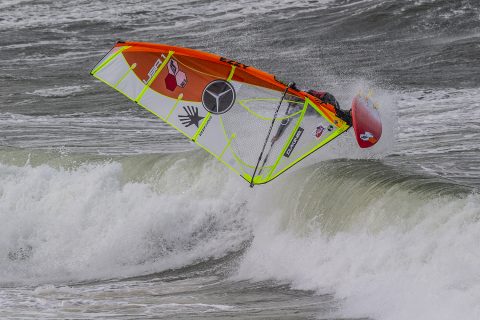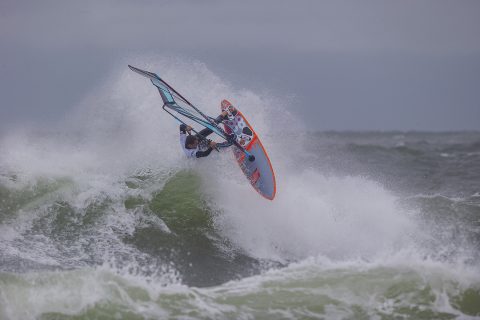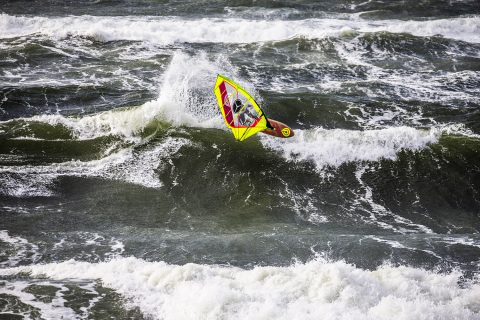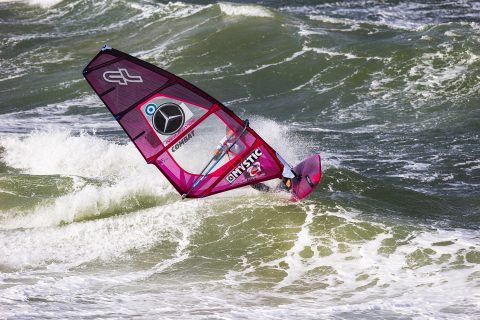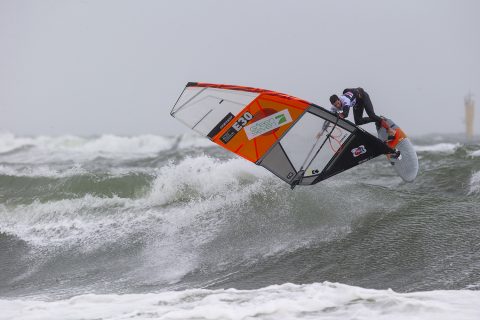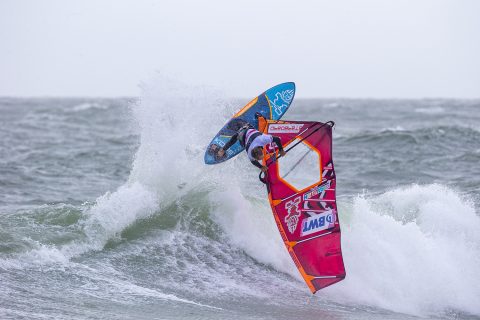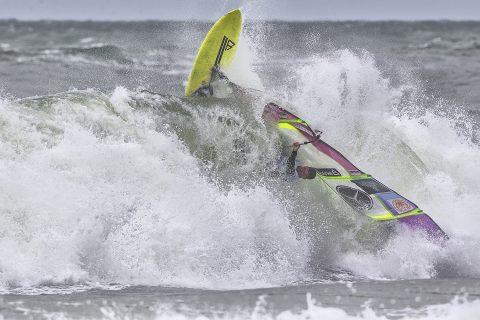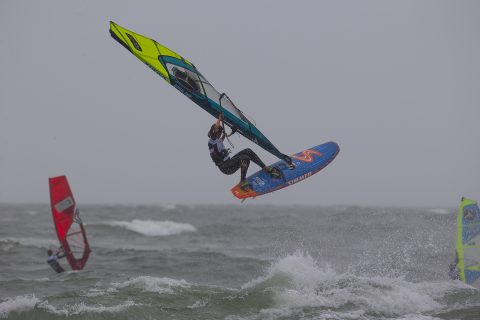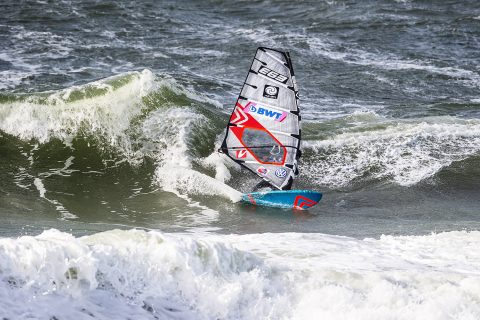The German leg of the 2019 PWA wave world tour once again showed Sylt’s reputation as a formidable contest arena. It is a maker or breaker of dreams; a cruel sea. JC gets the thoughts of some of the top pros on the challenges of the North Sea.
Words Thomas Traversa, Graham Ezzy, Antoine Martin, Marcilio Browne, Robby Swift, Alex Mussolini, Jaeger Stone, Ricardo Campello, Justyna Sniady, Iballa Moreno. // Photos John Carter
THOMAS TRAVERSA
I am 1.78 m and 62 kg. The board I used is my 70 litre, 220 x 55 cm. We originally designed that board for Maui, but it works everywhere for me, it’s one of those magic boards! That is the board I was using in Tenerife for the PWA and also the Aloha Classic. It is pretty wide in the centre, but the tail is very narrow, so there’s a lot of curve on the outline. It is floating a lot because of the 55 cm in the middle, but once you get on the rail it feels like a tiny board. Rocker is the same as I use on all my boards, 20 mm, that’s more than on a production board (around 15 mm on the small Da Curve from Tabou), but that’s not too extreme. For example I used to have 24 mm on my boards when I won the PWA title, but the last three years we added channels so I can have a quicker rocker line.
For the sail on Sylt I like to have a good downhaul tension to deal with the gusty wind and to keep a light feeling. Then when it gets really light I just use less outhaul tension, that helps lift the board out of the water and make the sail more reactive. Boom maybe a touch higher to lift the board up. I have no special tactics, just going for it and try to use the wave more than the wind. I just try to focus on the waves because they are very powerful and hard to read so I always try to attack them as hard as I can.
“Sylt is a big dune pretending to be an island.”
- Click to Enlarge
GRAHAM EZZY
Sylt is a big dune pretending to be an island; every storm threatens to wash it all away. As windsurfers, we see the island as any other beach town with mediocre surf. But for Germans, Sylt is ritz and glitz. We, the world cuppers, hole up in the city of Westerland and never go the 10 minutes north to the towns like Kampen, home to the second homes of Germany’s economic elites. On Sylt, life is transient. You struggle to find much in the way of roots. Sylt is a place for summer homes and dune grass, champagne and summer birds.
In pro windsurfing, there are two kinds of windsurfers – those who like Sylt and those who hate it. Morgan Noireaux hates Sylt so much, he didn’t even show up this year. I like Sylt, and I dream about doing well there. Sylt is a true test of the fundamentals; you don’t win in Sylt because you can do the best tricks. You win heats in Sylt when you manage to not get destroyed by the shorebreak or when you actually manage to catch a wave and time your bottom turn correctly. Too early, and you go off the back of the wave, defeated. Too late, and the lip, throwing itself with the power of thousand punches, smacks you down. Sylt makes novices of us all. The best thing about being a beginner again is that there is so much to learn.
I showed up late to Sylt, only arriving on the morning of the registration because a board had flown off the roof racks of my car while going 100 miles per hour on the autobahn while driving up from Hamburg. No one was injured except the board, thankfully, but it meant I missed the last car-train to Sylt.
In the old days, all the top pros had caddies to help them rig and to change equipment mid-competition or even to sail a spare rig out in the case of a broken mast. But now, only Philip Koester has a caddy, Jorge is his name, and the rest of us rely on a buddy system. “Is your heat coming up? No? Can you caddy me? I’m up next!” And whoever is able stands watch on the beach, ready to assist.
Before my own heat, I was frazzled. I had gotten married the weekend before, and I nervously fiddled with my wedding ring. I also suddenly noticed which men wore wedding rings and which men did not. My wife, my mother, my brother, and a girl my brother met at the wedding had all decided to come up to Sylt and were staying with me in a small 2-bedroom apartment. My brother and the girl slept on the couch. I ate breakfast quietly that morning so as not to wake them. As my heat approached, I ran my rigs upwind on the beach. I was in need of a caddy. Marcilio Browne stood in the sand, braving the chilling winds, staring at the horizon. My wife suggested that she could ask him to caddy for my next heat. But I could feel his nerves working on overdrive, the radiation spilling out. I saw Ross Williams to my left, and he took the caddy job without hesitation.
Browne went on to fight his way through the double elimination, ending up 2nd. The North Sea beat me on my own journey through the event, and I ended up 13th.
Losing is a hell of a hangover. All the spent endorphins and expired hope swirl together, and you wake up the next day lacking the brain chemicals that make you happy and motivated to function as a normal adult. The irony is that out of the whole 32 people in the Sylt World Cup, only one is the winner, and the rest of us lose. And winning does not feel nearly as good as losing feels bad. After the event, Jaeger Stone, Adam Lewis, and I had a moment together sharing our souls. Stone said, “Losing does not mean you’re a bad windsurfer,” and he paused, a thought came into his eyes, and he added, “or even a bad person.”
“Sylt is a big dune pretending to be an island.”
- Click to Enlarge
ANTOINE MARTIN
I am 1.76 m and 74 kg. I was happy to make 5th place in Sylt as they are conditions I am not used to at all. We had a great day there which was side-shore with some glassy waves and nice peaks. Suddenly I felt at home and could do tweaked airs and was feeling confident. As soon as it went onshore you could see the difference on my face. I have to work hard on those conditions to be one of the top guys. It is a challenging event and it feels better to do there when it was so tough. I did not realize at the time if I had beaten Koester in Sylt I could have been world champion. I was on my Combat 5.0 and Ultimate Wave 88 litre which is the biggest gear that I use during the year. I did not use 5.0 all year before the final in Sylt. I wanted to make sure I could get out. Sylt is Sylt and you must be lucky and have big gear. Everyone told me Brawzinho was heavier than me and made it out but he was on a really, really massive board which was over 100 litres and a 5.7 I think. I wasn’t ready for this. I wasn’t supposed to do the PWA this year so I had not prepared my gear for Sylt I just had a more normal quiver. If I had known maybe I would have had something bigger; 5.0 is already big for me. I am kind of light at 74 kg, so if I go over 5.0 then the conditions are very crap or very light wind. I was disappointed we ran in those conditions, but that is part of the game!
“If I had beaten Koester in Sylt I could have been world champion.”
- Click to Enlarge
MARCILIO BROWNE
I am 1.88 m and weigh 85 kg. I had two sets of production boards on the beach plus a 100 litre prototype. My production boards were 84, 89, and 94 litres. I feel like it was key having those extra set of identical boards as well as a caddy, none other than Francisco Goya himself. In pretty much all my heats, I ended up at some point stuck down the beach with the current and having another set of the correct size up the beach saved me a lot of time and energy. I could just run up and keep sailing while my caddy would recover the gear that was stuck downwind. On my 84 I rode MFC KS 14 and 9, on my 89 I rode MFC QS 250 centre with KS 9 sides and on the 94 I rode MFC QS 300 centre with KS 9 sides.
Before the event I was training a lot, to improve my fitness back on Maui. I have been working with Sarah Hauser for nearly a year and during this event in Sylt I really saw the benefits. I got a really bad flu right before the event in Sylt, it was hard to even get out of bed. After the competition started I didn’t have much expectations as I felt so crap. I also thought I would be cramping really soon. But things kept working out for me and I kept passing through my heats. I was really surprised that the first cramp I had was against Thomas in our second heat after the first one had been cancelled. During all my previous heats I was going out 8 minutes before to make sure I would make it through the shorebreak and also doing one or two sprints up the beach before each heat. So that day I think all the physical training really saved me and paid off, so big thanks to Sarah and also to Francisco and Matheus Isaac for all their help at the beach. My production boards are very similar to my customs, same bottoms, similar outlines, they are just a little shorter and a little straighter, which helps for small wave European conditions. I had been riding them all year so I really know them well. They fit really nice in Sylt as they are so fast and controlled, so it was easy to make it out past the shorebreak and to keep control on the chop to jump out the back. My sails are just the Banzais, and I rigged them with a bit less downhaul than I would at Ho’okipa, but all the rest of the settings were pretty much the same.
“I had two sets of production boards on the beach.”
- Click to Enlarge
ROBBY SWIFT
I am 1.75 m and 79 kg. I took a bit of everything to Sylt. I had the 83, 88 and 94 Ultimate Waves, which are pretty much my 3 go-to boards everywhere. They are 56.5, 58 and 59.5 wide respectively, all 227 cm long. And then for my new quiver this year, I have some prototypes of some amazing new boards which we are developing for next year. They are slightly shorter and wider, still 83, 88 and 94, but they are all 2 cm wider and about 5 cm shorter and have wider tails and noses and straighter rockers which makes them feel really amazing to get planing and to turn in the more onshore conditions. They keep the speed way more in the bottom turns where you have to go switch stance and clew first and they just pop up onto the plane in no time.
For the sails, I tend to use roughly one size bigger than normal when it’s onshore because it’s hard to get out and I put a tiny bit less downhaul on the sail and the boom up about 5 cm or so, to give more lift to get up and onto the plane as quickly as possible.
I spend quite a bit of time on Maui beforehand practicing with this setup because it feels quite different to land jumps and takes a bit of getting used to. The higher boom is the hardest thing for me to get used to, but it is worth it for the extra planing ability. To get out I just tried using bigger gear really and trying to go as far upwind as possible between the rock groynes before starting to head out. It’s amazing how quickly the current takes you up or down the beach and makes it feel like there is no wind.
A caddy would have been great. I didn’t have one this year and it meant it was hard to change gear in the middle of the heat. I definitely try to be as fit as possible before I get to Sylt. The energy it takes out of you to just do one heat is huge. You are pumping and fighting with the sail so much and using so much energy just to get out, and then you can’t really go too far out as there are no waves to jump or ride as soon as you get past the shorebreak, so you have to stay inside where the waves are breaking the whole time. It is definitely a very tough environment to windsurf and one that not many are totally prepared for.
“Boom up about 5 cm or so, to give more lift.”
- Click to Enlarge
ALEX MUSSOLINI
I am 1.79 m and I weigh around 70-72 kg. I am light but not Traversa light. I used a 82 litre board which is a side-onshore model John Skye has been working on for the last year. It is quite floaty and keeps planing really fast. I used a bigger thruster fin setup, 16 cm in the middle and 10 cm on the side, to help me go upwind. You can’t learn how to go through a shorebreak. You just have to come to Sylt and take it. After so many years of experience we kind of know where to spot the little gaps to break out. If you are lucky enough to be planing then you might get out. Top guys like Philip Koester and Antoine Martin were having big troubles. It can happen to anybody. Big sail and big board and that is it. Just get planing as soon as possible. You have to go downwind, but if you keep heading downwind you will end up in Hamburg! It was very tiring. I was out of breath many times. It was not just physical, time is ticking away, you are against the clock. There was a lot of fitness involved. We all saw Brawzinho, he is an athlete. Big respect for him. He is not only an amazing windsurfer, for me the best, but he is also fit and prepared. He is a true windsurfer. After nine heats he was finally destroyed, so Thomas managed to take the victory. Thomas is a beast also. It was all incredible to watch. It was all about experience. You had to make sure your jumps were in the bag before taking the waves. The older more experienced guys prevailed.
“The older more experienced guys prevailed.”
- Click to Enlarge
JAEGER STONE
I am 1.77 m and 73 kg. The equipment for Sylt is make or break. Selection is one of the most important things when sailing in Germany. Some guys are more prepared than others and know what to expect when you get one of those gnarly bolt onshore days. Also having your backup gear readily available is critical so you can swap quickly if you get washed. You have to take into account the current, the sweep along the beach, the shorebreak and the wind angle. It is tough, but all part of the game. The guys that are switched on like Brawzinho come out on top. He is very prepared for every scenario. I took my big board but not my biggest board. I felt that let me down slightly. I was on my 76 litre UltraKode and my 4.4 S1. I needed to be
on my biggest onshore board my 80 litre. That is the biggest I would use anywhere. I was powered up on 4.4 and didn’t think I would need it but I could hardly get off the beach. I learned the hard way. I don’t think many average sailors would even be able to get out in those conditions. It is easy to watch at home but incredibly tough. Even Koester could not make it out. It is so physical. It does not matter who you are or how good you are. It is the most physical competition on tour and fitness comes into it. I sailed way down the beach past where I get a crepe in the morning and there was still no gap. I thought about turning around but could not see a way out unless I kept going. I wasted a lot of time but the other option was to run back. Tactics come into play. If you catch a wave at the start of the heat you may not make it out again. You have to weigh up the risks versus the rewards. It is very tough. I just try to learn from my mistakes!
“The equipment for Sylt is make or break.”
- Click to Enlarge
RICARDO CAMPELLO
I am 1.78 m and 79 kg. In Sylt anything can happen. Every heat I had there was a big rain squall right before which totally killed the wind. I did not know whether to take small equipment or my big gear. During the rain squalls it was getting pretty windy and afterwards there could easily be next to nothing. You always have to go bigger than normal. In all the heats on the first day I was on a 94 litre board, which was ok with a 5.3. I just had no power to do anything. It was not a matter of the gear. How big can you go for a wave event? On the bolt onshore day it was windier so I took 4.7 and 5.0. I think my fins were 13 in the back and 9 in the front with a quad setup. The wind was so onshore and the inside is just whitewater foam. The wind hits the tent and bounces back to create a total no wind zone. Every time a sailor goes downwind, their wind is blocked. If you are lucky you make it out. Sometimes you have to go to the beach and walk or run back up. If you don’t clock up a high scoring wave and mess it up you can be done as you might not make it out. I did not feel it was fair, it was a matter of luck. Brawzinho had a great comeback to make it into second. I lost to Brawzino and just could not find the ramp to nail a double. He had a better advantage to me on the jumps, but I had better waves. It is what it is and there is nothing I can do.I was bummed I dropped some places on the overall rankings.
“In Sylt anything can happen.”
- Click to Enlarge
JUSTYNA SNIADY
I am 1.70 m and 62 kg. I took the gear I could uphaul on. The 78 litre Simmer Cortex and my 4.7. That was the biggest gear I own. I was running up and down frantically trying to get out and swapping to my 78 litre Flywave and 4.5 which was my backup gear so I didn’t have to run up the beach with the gear every time. Sylt is always tough, but with a bit more wind it is doable to make it out through the shorebreak. In my heat the wind died to nothing on the inside and I had to physically hold the sail up when trying to beach start. I had a gust at one point but it wasn’t enough to get over the dumpy shorebreak; you had to be lucky and get a gust together with a break in the oncoming waves. I wasn’t lucky this time and ended up getting washed very far down which drained my energy. I tried to make it out 15 minutes before my heat, but every attempt went wrong and I was running up and down the beach getting really anxious. What you try to do is get planing before you start hitting the waves but the problem is that the waves can double up and the wind drop to nothing and there is no chance to get through sometimes. The tent plays with the wind also, making it extra light just in front of it. I felt helpless, it was terrible not to even make it out during my double elimination heat and lose a tour leader position this way, but that’s competition.
“I took the gear I could uphaul on.”
- Click to Enlarge
IBALLA MORENO
I am 1.73 m tall and 61 kg. Sylt was straight onshore with a tonne of current and pretty much the hardest competition I have ever done in my life during 22 years of competing. I did so much swimming and running trying to get out, my body was totally aching the next morning. I felt like I had done a triathlon. I had a 4.7 and an 80 litre board, on the inside it was impossible to get out while on the outside I was totally overpowered. Not only because of the wind but also the current. It was not just the girls, even the men could not punch out. With two jumps counting it was almost impossible. It was a lottery and you can’t train enough for this. I tried my best but it didn’t work. Mentally it was very tough. I was getting washed so hard I was dizzy and I could not really run. I was trying not to get emotional and just do my job but it did not work. It is hard to wave sail in a straight onshore wind. I am glad the girls have a discard this year. It was not equipment it was a matter of luck if you had a gap. The tactics were to try and do two jumps, it didn’t matter which tack and then ride waves in bolt onshore. Basically on any normal day you would never sail in that, you would look down the coast for a better angle. It was good for the winners but a lot of people were pretty upset.
“The hardest competition I have ever done.”

